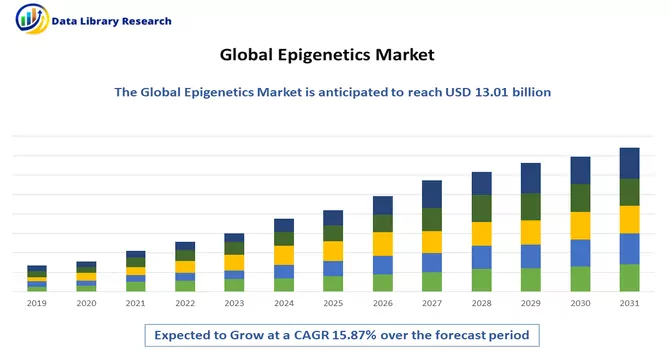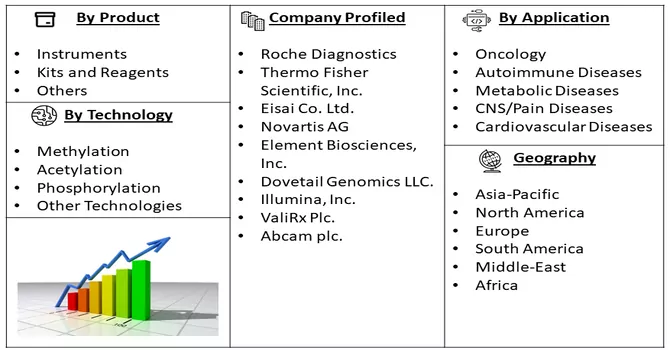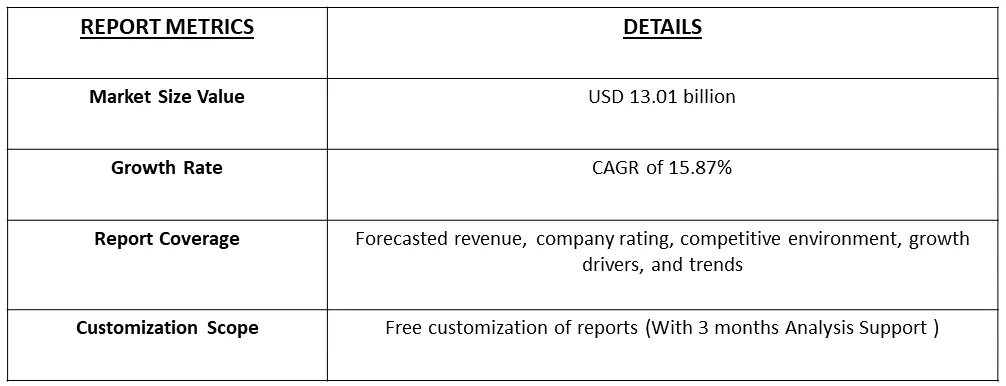As of 2022, the global epigenetics market had attained a valuation of USD 13.01 billion, with expectations of a robust compound annual growth rate (CAGR) of 15.87% from 2023 to 2030.

Get Complete Analysis Of The Report - Download Free Sample PDF
This significant growth is primarily attributed to increased investments, funding, and approvals for research and development in the field of epigenetics, coupled with the expanding applications of epigenetics in drug discovery and development. Additionally, the heightened affordability of genome sequencing has played a pivotal role in driving market expansion. The versatility of epigenetics applications in non-oncology conditions has further opened substantial opportunities for market growth. Epigenetic pathways are implicated directly or indirectly in various conditions, including cancers, Cardiovascular Disorders (CVDs), reproductive issues, autoimmune diseases, and conditions affecting cognitive function.
The Epigenetics Industry involves the examination of alterations in gene expression or cellular phenotype that do not stem from changes in the DNA sequence itself. These alterations are both heritable and reversible, influencing gene expression and regulation without modifying the underlying genetic code. The field encompasses diverse mechanisms, including DNA methylation, histone modifications, chromatin remodeling, and non-coding RNAs.
Epigenetics plays a pivotal role in diseases such as cancer, neurodegenerative disorders, and autoimmune conditions. The comprehension and manipulation of epigenetic mechanisms present potential therapeutic avenues for addressing these diseases. The development of drugs targeting epigenetic modifications, known as epigenetic drugs or modifiers, is a focal point of drug development in the industry. Epigenetic markers also serve as potential biomarkers for diagnosing diseases, predicting prognosis, and forecasting treatment responses. Profiling epigenetic signatures in individuals contributes to the emergence of personalized medicine, allowing tailored treatment strategies based on individualized epigenetic profiles.
Epigenetics assumes a pivotal role in the onset of diseases like cancer, neurodegenerative disorders, and autoimmune conditions. The comprehension and manipulation of epigenetic mechanisms present promising therapeutic pathways for addressing these diseases. A focal point in drug development is the creation of drugs that target epigenetic modifications, commonly referred to as epigenetic drugs or modifiers. Epigenetic markers emerge as potential indicators for diagnosing diseases, forecasting prognosis, and predicting responses to treatment. The capability to profile individualized epigenetic signatures contributes significantly to the evolution of personalized medicine, guiding the formulation of tailored treatment strategies based on unique epigenetic profiles.
Market Segmentation: The Epigenetics Market is Segmented by Product (Instruments, Kits and Reagents, Others), Application (Oncology, Autoimmune Diseases, Metabolic Diseases, CNS/Pain Diseases, Cardiovascular Diseases), Technology ( Methylation, Acetylation, Phosphorylation, Other Technologies) and Geography (North America, Europe, Asia-Pacific, Middle East and Africa, and South America). The report offers the value (in USD million) for the above segments.

For Detailed Market Segmentation - Download Free Sample PDF
Market Drivers:
Increasing Therapeutic Potential and Drug Development
The pharmaceutical industry has shown a keen interest in the therapeutic potential of epigenetics. Epigenetic modifications play a pivotal role in various diseases, encompassing cancers, neurological disorders, and autoimmune conditions. This awareness has spurred the development of drugs specifically targeting epigenetic mechanisms, such as DNA methyltransferase inhibitors, histone deacetylase inhibitors, and other epigenetic modifiers. The pursuit of these innovative therapeutics has catalyzed significant investment and research in the epigenetics market, propelling advancements in drug development and the initiation of clinical trials for potential treatments. For instance, as per the World Health Organization (WHO) report published in April 2023, there has been a notable increase in the weighted average health Gross Domestic Expenditure on Research and Development (GERD) as a percentage of GDP, particularly in high-income nations.
This surge can be attributed to the growing prevalence of GERD in several of these high-income countries. Notably, the Republic of Korea reported the most substantial increase, from USD 3.8 billion to USD 4.5 billion in 2020, followed by Greece, which saw an increase from USD 513 million to USD 598 million in 2020. Both nations reported an upsurge of over 15%. Furthermore, a significant development in the field occurred in February 2021 when the International Cancer Genome Consortium (ICGC) launched the ICGC ARGO Data Platform. This platform marked a significant stride forward following the ICGC 25K Data Portal. ARGO, a global initiative aimed at advancing cancer genetics, provides high-quality clinical, genomic, and molecular data to researchers worldwide, fostering collaboration and progress in the understanding of cancer genetics. Thus, the above-mentioned factors are expected to drive the growth of the studied market over the forecast period.
Rising Applications in Precision Medicine
Epigenetics contributes significantly to the concept of precision medicine by offering insights into individual variations in gene expression patterns and disease susceptibility. The ability to profile epigenetic signatures allows for personalized treatment approaches tailored to individual patients. This trend aligns with the growing demand for personalized and targeted therapies, where epigenetic analysis contributes to better patient stratification, treatment selection, and monitoring of treatment responses. For instance, in January 2023, Agilent Technologies, Inc., announced the acquisition of Avida Biomed, a company that develops target enrichment workflows for clinical researchers utilizing NGS methods to study cancers. Thus, the above-mentioned factors are expected to drive the growth of the studied market over the forecast period.
Market Restraints:
Complexity and Understanding of Epigenetic Mechanisms and Lack of Standardization and Reproducibility
Epigenetics encompasses intricate regulatory mechanisms governing gene expression. Grasping the intricacies of epigenetic modifications, their interplay, and their functional consequences in various diseases poses a formidable challenge. The complexity inherent in epigenetic networks can act as a barrier to the development of targeted therapies and diagnostics. Additionally, the standardization of methodologies and assays for investigating epigenetic modifications is pivotal. Ensuring reproducibility and comparability of results across diverse laboratories and studies is dependent on the uniformity of experimental protocols, sample handling procedures, and data analysis methods. Discrepancies in these aspects can introduce inconsistencies, impeding the validation of research findings and complicating the translation of such research into clinical applications.
The pandemic prompted a shift in research priorities and resources toward understanding SARS-CoV-2 and developing diagnostics, treatments, and vaccines. Many research laboratories temporarily redirected their efforts and resources away from non-pandemic-related studies, including epigenetics research, leading to disruptions and delays in ongoing projects. Clinical trials involving epigenetic-based therapies or diagnostic approaches faced disruptions due to lockdowns, travel restrictions, and limitations on patient recruitment and monitoring. The pandemic-related constraints on conducting in-person visits and data collection affected the progress and timelines of clinical studies in the epigenetics field.
Segmentation Analysis:
Autoimmune Diseases Segment is Expected to Witness Significant Growth Over the Studied Period
Epigenetic alterations, such as DNA methylation, histone modifications, and non-coding RNA regulation, are implicated in autoimmune diseases' pathogenesis. Studying these modifications helps identify specific epigenetic signatures associated with different autoimmune conditions. These signatures can serve as potential biomarkers for disease diagnosis, prognosis, and monitoring of disease activity.
Additionally, the increasing prevalence of autoimmune diseases worldwide, coupled with a growing awareness of health and diseases, underscores the demand for diagnostics for early disease detection, thereby fueling market growth. Organizations such as the American Autoimmune Related Disease Association (AARDA) contribute to this awareness by designating March each year as Autoimmune Disease Awareness Month (ADAM), focusing on the eradication of autoimmune illnesses and mitigating their impact on individuals and society. In February 2021, the American Kidney Fund (AKF) launched an educational and awareness campaign specifically targeting lupus nephritis, a kidney condition caused by lupus. This initiative aimed to provide crucial information to lupus patients about symptoms, diagnosis, and treatment for lupus nephritis, supported by grant funding from GlaxoSmithKline plc.
Similarly, in September 2021, Scipher Medicine entered into a partnership with Ventegra Inc., allowing Ventegra to offer its customers access to Scipher's PrismRA liquid molecular signature test. This test aids in determining the most targeted medicine for rheumatoid arthritis patients (RA). These collaborative efforts and initiatives are expected to contribute significantly to market growth, driven by the increasing emphasis on early detection and tailored treatment approaches for autoimmune diseases.
Methylation Segment is Expected to Witness Significant growth Over the Studied Period
The DNA Methylation segment is anticipated to command a significant share in the market throughout the forecast period. This dominance can be attributed to the prevalent use of DNA methylation, a process involving the covalent addition of a methyl group to the cytosine ring, resulting in the inhibition of transcription. DNA methylation is effectively employed in various techniques such as methylation-sensitive PCR (MSP), real-time PCR for methylation detection, methyl light, and quantitative analysis of methylated alleles. Technological advancements play a pivotal role in the growing adoption of locus-specific DNA methylation assessment on a genome-wide scale, thereby propelling the market forward. Notably, innovative fundraising initiatives by DNA methylation start-up companies are expected to further drive market expansion.
An illustrative example is Base Genomics, an epigenetics firm that raised an impressive USD 11 million (GBP 9 million) in a seed investment round in June 2020. This funding, led by Oxford Sciences Innovation and supported by investors experienced in genomics and cancer research, is poised to stimulate increased research on DNA methylation. This, in turn, is expected to boost the adoption of reagents, kits, and instruments for DNA methylation, contributing to overall market growth. In addition, advancements in technology are fostering the introduction of new solutions, such as the Twist NGS Methylation Detection System launched by Twist Bioscience Corporation in February 2021. This comprehensive system offers end-to-end sample preparation and target enrichment for identifying methylated regions in the human genome. Such innovations are anticipated to drive the increased adoption of DNA methylation for studying the human genome in research and the development of novel therapies.Thus the given these factors, the DNA Methylation segment is positioned to be a significant driver of market growth over the forecast period.
North America Region is Expected to Witness Significant growth Over the Studied Period
The factors owing to the growth include rapid developments in healthcare infrastructure, the presence of major regional players, huge investments in research and development, and the rising prevalence of cancers, among others. With increasing investments in the research and development of products by industries, the demand for protein expression systems is expected, as many mammalian proteins, such as growth hormone, insulin, antibodies, and vaccines, are produced industrially.
The pandemic prompted a shift in research priorities and resources toward understanding SARS-CoV-2 and developing diagnostics, treatments, and vaccines. Many research laboratories temporarily redirected their efforts and resources away from non-pandemic-related studies, including epigenetics research, leading to disruptions and delays in ongoing projects.
Furthermore, the increasing prevalence of cancer is playing a significant role in propelling market growth in the region. For example, according to the American Cancer Society (ACS), an estimated 1,918,030 new cancer cases are anticipated in the United States in the year 2022. This substantial cancer burden underscores the imperative for enhanced diagnostics and therapeutics, driving the market's growth through the widespread adoption of epigenetics in cancer research.
Additionally, the United States witnesses heightened investments by market players dedicated to advancing epigenetics, contributing to the region's market expansion. Notably, in November 2021, Chroma Medicine, Inc. (Chroma), an emerging genomic medicine company specializing in epigenetic editing, was launched with a substantial financing of USD 125 million. Chroma aims to address a diverse range of diseases and position itself as the preferred technology for gene regulation.Considering these factors, the market is poised for growth over the forecast period.

Get Complete Analysis Of The Report - Download Free Sample PDF
The epigenetics market demonstrates a moderate level of competitiveness, with key players strategically expanding their portfolios through substantial investments in research and development, fundraising, and strategic collaborations with other companies. These major market players are actively engaged in acquisitions, contributing to the growth and evolution of the epigenetics sector. This dynamic market presents numerous opportunities for both new entrants and established leading players.The influx of technological advancements is anticipated to be a significant catalyst for market growth throughout the forecast period. These advancements not only drive innovation but also open up avenues for novel solutions and approaches within the epigenetics field.
Some of the prominent players in the global epigenetics market include:
Recent Developments:
1) In February 2022, Zenith Epigenetics Ltd. reported the dosing of the first patient with a combination of ZEN-3694 (BET inhibitor) + Bristol Myers Squibb's PD-1 immune checkpoint inhibitor OPDIVO and YERVOY in a National Cancer Institute (NCI), part of the National Institutes of Health, sponsored trial in solid tumor cancer.
2) In February 2022, Element Biosciences, Inc., developer of a new and disruptive DNA sequencing platform, entered a partnership with Dovetail Genomics to demonstrate the value and performance of Dovetail's proximity ligation-based-based next-generation sequencing (NGS) library prep solutions on Element's AVITI System.
Q1. What was the Epigenetics Market size in 2022?
As per Data Library Research the global epigenetics market had attained a valuation of USD 13.01 billion in 2022.
Q2. At what CAGR is the Epigenetics Market projected to grow within the forecast period?
Epigenetics Market is expected to reach at a compound annual growth rate (CAGR) of 15.87% over the forecast period.
Q3. What are the factors driving the Epigenetics Market?
Key factors that are driving the growth include the Increasing Therapeutic Potential and Drug Development and Rising Applications in Precision Medicine.
Q4. Which Region is expected to hold the highest Market share?
North America region is expected to hold the highest Market share.
Data Library Research are conducted by industry experts who offer insight on industry structure, market segmentations technology assessment and competitive landscape (CL), and penetration, as well as on emerging trends. Their analysis is based on primary interviews (~ 80%) and secondary research (~ 20%) as well as years of professional expertise in their respective industries. Adding to this, by analysing historical trends and current market positions, our analysts predict where the market will be headed for the next five years. Furthermore, the varying trends of segment & categories geographically presented are also studied and the estimated based on the primary & secondary research.
In this particular report from the supply side Data Library Research has conducted primary surveys (interviews) with the key level executives (VP, CEO’s, Marketing Director, Business Development Manager and SOFT) of the companies that active & prominent as well as the midsized organization
FIGURE 1: DLR RESEARH PROCESS

Extensive primary research was conducted to gain a deeper insight of the market and industry performance. The analysis is based on both primary and secondary research as well as years of professional expertise in the respective industries.
In addition to analysing current and historical trends, our analysts predict where the market is headed over the next five years.
It varies by segment for these categories geographically presented in the list of market tables. Speaking about this particular report we have conducted primary surveys (interviews) with the key level executives (VP, CEO’s, Marketing Director, Business Development Manager and many more) of the major players active in the market.
Secondary ResearchSecondary research was mainly used to collect and identify information useful for the extensive, technical, market-oriented, and Friend’s study of the Global Extra Neutral Alcohol. It was also used to obtain key information about major players, market classification and segmentation according to the industry trends, geographical markets, and developments related to the market and technology perspectives. For this study, analysts have gathered information from various credible sources, such as annual reports, sec filings, journals, white papers, SOFT presentations, and company web sites.
Market Size EstimationBoth, top-down and bottom-up approaches were used to estimate and validate the size of the Global market and to estimate the size of various other dependent submarkets in the overall Extra Neutral Alcohol. The key players in the market were identified through secondary research and their market contributions in the respective geographies were determined through primary and secondary research.
Forecast Model
